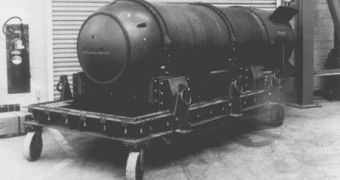That's exactly what the U.S. Air Force did exactly five decades ago. The funny thing is that they know the general area where the bomb might be, but they have been unable to find it event to this day. The incident took place on the 5th of February 1958 when a B-47 bomber carrying a Mark 15 hydrogen bomb collided, in the air, with a F-86 fighter during a practice exercise. Although severely damaged, the B-47 bomber was still able to fly, but, in order to reduce the risk of a uncontrolled landing and possible explosion of the atomic weapon, the crew requested to drop it over water, near the mouth of the Savannah River.
The bomber plane eventually was successful in maintaining its flight capabilities and landed safely at the Hunter Air Force Base. The F-86 fighter, on the other hand, was not so fortunate, and the pilot had to eject to save his life. Although falling from a hight of 2.2 kilometers at a speed of about 370 kilometers per hour, the atomic bomb did not explode on impact and may still be lying intact near the shores of the Tybee Island.
The next day, the U.S. Air Force began search and retrieval operation with sonar and galvanic drag and sweep cables, but after two months of continuous search found nothing and decided to stop the search effort. Hydrological surveys of Wassaw Sound body of water revealed that the bomb might actually lie buried under a layer of 2 to 5 meters of sediment.
In the recent years, search operations have resumed under the command of Colonel Derek Duke and identified a possible location of the bomb just one mile away from the Tybee Island, where the level of radiation is about seven times higher than in the surrounding areas. Nonetheless, later it was shown that the radiation emissions are actually determined by natural uranium deposits in the area and the hydrogen bomb went missing once again.
The explosive device is a Mark 15 hydrogen bomb, measuring four meters in length and weighing 3,5 metric tonnes. It contains quantities of enriched uranium and about 180 kilograms of explosive materials, besides the hydrogen charge. It is now considered irretrievably lost, since the Air Force decided the safest thing to do is to leave it encased in the mud of the Wassaw Sound water body, rather than set for search operations that could rise the risk of a potential explosion.

 14 DAY TRIAL //
14 DAY TRIAL //